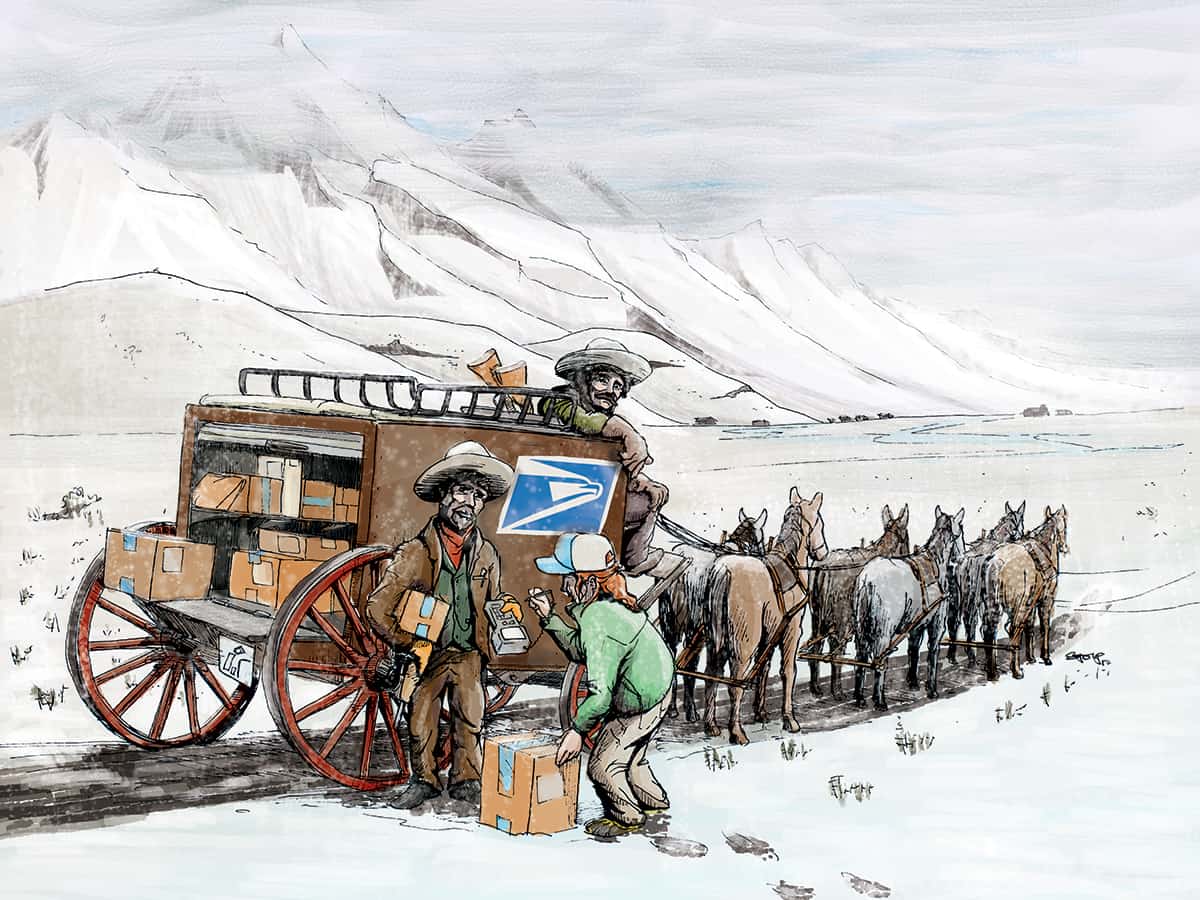Read The
Current Issue
Post Office Blues
Locals love to hate that there is no home delivery of mail in Jackson Hole.
By Erika Dahlby – Illustration by Ryan stolp
DOREEN TOME WALKS to the post office every day, checking her P.O. box for hand-written letters and the local paper, and occasionally buying stamps at the counter. But the highlight is the people, not the mail: it’s the long-time employees, her friends, and her fans. (Tome has written the Jackson Hole News&Guide’s JH Senior column for nine years and readers always stop her to chat.) “It may be one of the last vestiges of this [Jackson] feeling like a small town,” she says.
Tome has had a box at the downtown post office, run by the federal U.S. Postal Service (USPS), for almost forty years—always the same box number. Back then, getting a box wasn’t an easy task; there was a waitlist of more than one hundred people.
As the town’s population grew, the downtown post office added additional boxes. In the early nineties, the USPS even opened an annex with about two thousand boxes in Stone Drug, on West Broadway, to keep up with the demand. In the mid-nineties the agency built a 25,000 square-foot, modern-but-utilitarian post office on the west side of town. Twenty-three years later, locals still call it the “new post office.” The postmaster at the time dubbed it the “biggest change in Jackson’s history of mail delivery.” Today though, many locals say the two post offices aren’t enough. The lines at the new post office can be fifteen or twenty minutes long on an average day.
Today, when the question of why mail is not delivered to street addresses in Jackson comes up, the new post office is mentioned along with tales of the town voting the service down. “I’ve been here thirty-eight years and I’ve never seen that vote go by,” Tome says. That’s because the “vote” happened several years before Tome’s arrival. And because it wasn’t exactly a vote.
In 1974, the town’s population was a little over two thousand. The local and regional USPS offices studied the possibility of home delivery in town. The postmaster at the time, Floyd Graefe, thought it was a no-brainer that locals wanted it. The regional office in Cheyenne concluded that Jackson was physically set up to have home delivery. With the USPS determining that it was an option, the decision was given over to the community. The agency sent out surveys about the idea to eligible residents. Informal polls indicated that more than 50 percent of locals wanted home delivery, but only 20 percent of those receiving the survey responded. For the results to be valid, the USPS required a response rate of at least 75 percent.
So, the end result of this “vote” was no home delivery of mail in Jackson. The idea resurfaced occasionally in the ensuing years, but nothing came of it. Once the USPS invested $4 million in building the new post office and it opened in 1994, the fate of home delivery was pretty much sealed. Still, locals enjoy complaining about it, especially now as more and more shopping is done online. It’s not uncommon for packages to be returned to, say, Amazon because they arrive at the Jackson post office bearing only a street address. And, during the holidays, you might have to wait in line for thirty minutes to pick up your packages.
Still, “If you go at the same time every day you’ll see the same people with such frequency that you could set your clock to the faces you see at a particular time,” says Erika Hartenstein, 39, a Jackson local who’s been going to the downtown post office since 1992. “This can only happen in Jackson.”
HOw to mark your package right:
“Put your PO Box number in every possible spot—it’s the only way to ensure you’ll get your package,” is the advice given at all of the valley’s post offices. How many different ways can you do this?
1. John Doe 1234
2. 123 Broadway Ave, #1234
3. PO Box 1234
4. Jackson, WY 83001-1234





